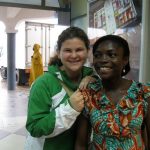“You are welcome,” said an elderly woman. Wrinkles folded up around her eyes as she smiled at me. As I stepped into the courtyard, she directed me to remove my sandals, lent me one of her head coverings to wear over my hair and poured water on my feet to clean them.
When we approached the temple, a big all-white building with two towers at its front, I mimicked her wiping her feet on mats and towels. Inside music from a Yamaha keyboard echoed around the open room. Men and women swayed to the choir’s song. Many punctuated the beat by shaking a white handkerchief. A few held up their hands.
Ghanaian style—most evident in the country’s bright, multicolored and patterned textiles—was reflected even in the members’ all-white garb. Spiraling flowers, lace, embroidery, eyelets, sequins and rhinestones decorated many of the smocks, dresses, head coverings and pants. I felt conspicuous in my grey skirt and white shawl that kept slipping back on my head. I was also the only white person among the 300 or so worshipers. Yet everyone who caught my eye smiled. “You are welcome,” they kept telling me. I believed them.
For the next three hours I did my best to participate (while taking pages of notes, of course). I stood, danced to the upbeat songs and prostrated when everyone else did. My guide, a man named Fred who was brought to sit with the obruni visitor, asked me if I’d like to “take water.” I nodded and followed him to one corner. Copying what he and the others did, I cupped my hands and drank the sacred water, which Fred later told me was bottled. (Phew.) I took two pieces of cola nut but didn’t know what to do with them, so I swallowed them whole—and nearly gagged as the sharp edges caught in my throat. I also wiped the faintly scented florida water on my skin.
I understood a total of two words as members stood up to testify or announce the social calendar. They spoke in Twi, Akan and Ga. That they could understand each other is remarkable to me but a testament to how closely related some Ghanaian languages are—and how multilingual many Ghanaians are.
Afterwards Fred sat with me, explained the basics of Zetaheal and answered my many questions. Zetaheal was formed in 1975 when the prophetess Lehem, then known as Comfort, received divine messages from angels who spoke through her. The religion aims to correct mistakes in Islam and Christianity and to bring the two faiths together. It also takes influences from indigenous beliefs, such as reincarnation and the sanctity of nature. “It’s sacrilege to cut down rainforests for money,” Fred told me at one point. Zetaheal recognizes many prophets—not just Jesus and Mohammed, but also the Buddha, Zoroaster and Confucius.
I am thrilled at the prospect of learning more about this religion. I’m not quite as excited about the idea of finding my way to the temple by 5am on Fridays and Sundays for the beginning of worship, but I bet exploring the many facets of Zetaheal will turn me into an early bird.
“You are welcome,” they told me. I’m going to take them up on it.
-Catherine Ryan



Joyce Fisher
August 8, 2011 — 1:48 am
Dearest Catherine,
I wish I could go to temple with you. Zetaheal sounds like the religion that I have looked for all of my life. I have always believed that there is not a single religion practiced today that has it totally right, but I also believe that in almost every religion there are aspects that are exactly right. Always I’ve wondered what could happen if those aspects from each religion could be combined. People from all walks of life throughout the world could find peace. I’m so glad you shared this experience with me!
Peace, Love & Joy,
Joyce